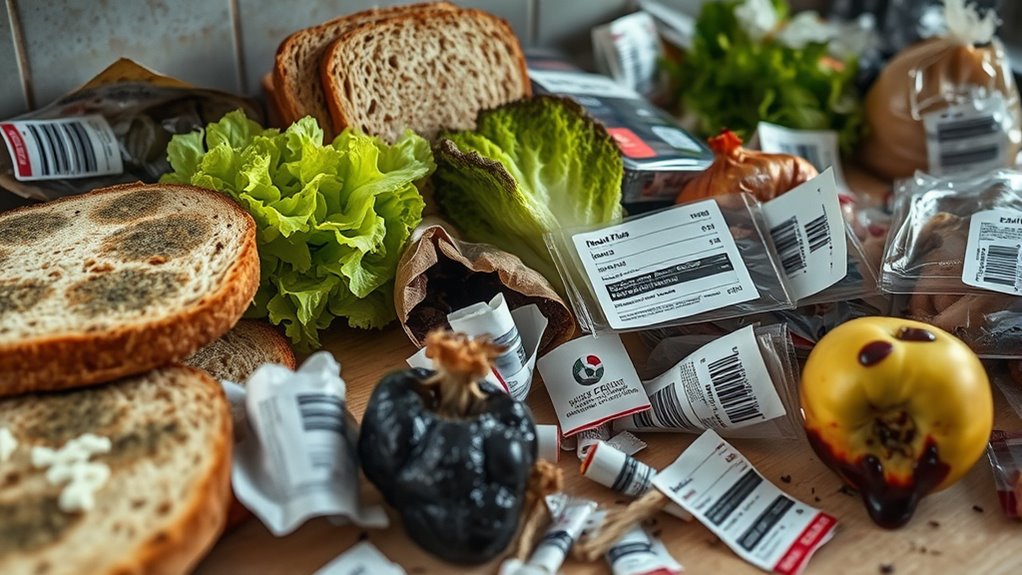To manage spoiled food codes and stay compliant, you need to understand what each label means, like “Best By,” “Use By,” and “Sell By.” Always implement a FIFO system, conduct regular inspections, and accurately record conditions and dates. Train staff to spot spoilage signs and stay updated on safety regulations. Keep detailed documentation and follow clear protocols for discrepancies. Keep these rules in mind, and you’ll master the essentials—there’s much more to explore ahead.
Key Takeaways
- Immediately document and isolate spoiled items, following proper disposal and cleanup procedures to prevent contamination.
- Verify expiration and spoilage indicators against labels and visual cues during inspections.
- Ensure staff are trained to recognize spoilage signs and understand proper handling protocols.
- Maintain accurate records of spoilage incidents, corrective actions, and compliance checks for audits.
- Stay updated on food safety regulations and standards to ensure ongoing compliance and effective spoilage management.
Understand the Meaning Behind Food Codes and Labels

Understanding food codes and labels is essential for determining whether your food is still safe to eat. Food label terminology can be confusing, but knowing what these labels mean helps you identify spoilage indicators. Look for expiration dates, but also pay attention to codes like lot numbers or production dates that manufacturers include. These codes often reveal how fresh the product is and whether it’s past its prime. Spoilage indicators, such as changes in color, texture, or smell, are also critical clues. Recognizing these signs, along with understanding the labeling system, helps you make informed decisions and avoid consuming unsafe food. Proper interpretation of food labels guarantees your safety and reduces waste from discarding still-edible products. Additionally, familiarizing yourself with food code systems can help you quickly assess product freshness and safety.
Recognize the Difference Between “Best By,” “Use By,” and “Sell By” Dates
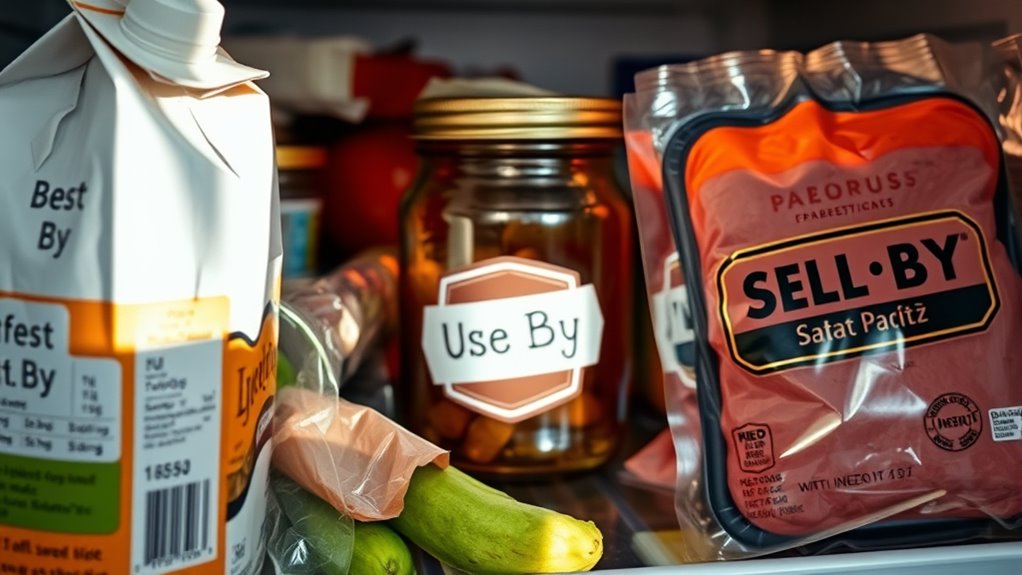
Knowing the difference between “Best By,” “Use By,” and “Sell By” dates is essential for managing food safety and quality. These labels help you determine how long food remains fresh and safe for consumption. “Best By” indicates peak quality; it isn’t safety-related. “Use By” is the last date recommended for consumption, especially for perishable items. “Sell By” guides stores on inventory timing but isn’t a safety indicator. Proper food storage and labeling standards help prevent spoilage. Here’s a quick reference:
| Label | Meaning | When to Consume |
|---|---|---|
| Best By | Quality peak, not safety | Before date for best flavor |
| Use By | Safety-related, especially for perishable foods | By date for safety |
| Sell By | Store inventory, not safety | Before date for freshness |
Understanding these distinctions keeps your food safe and reduces waste. Food labeling standards play a crucial role in preventing confusion and ensuring food safety at home and in stores.
Familiarize Yourself With Industry and Regulatory Standards
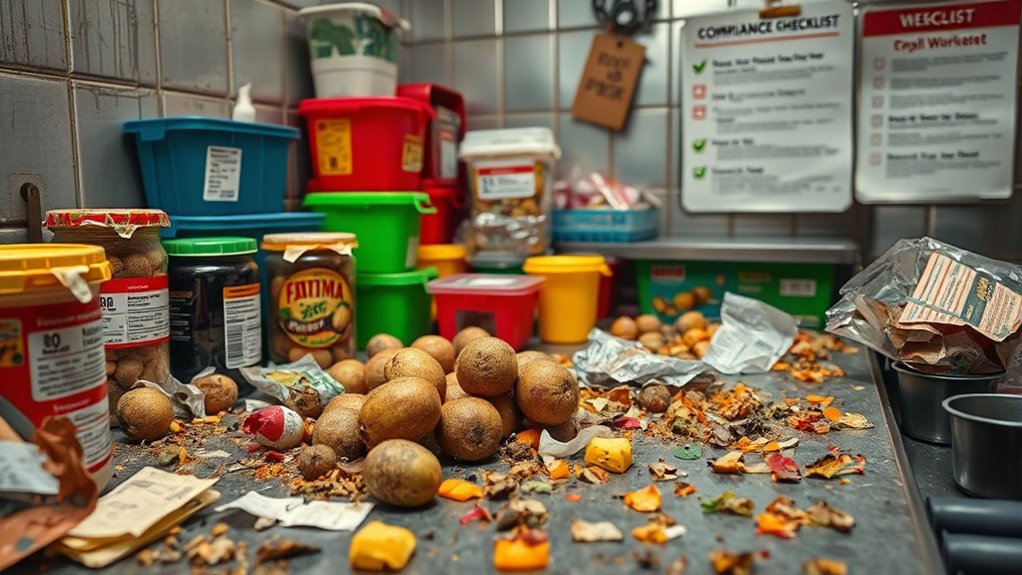
Familiarizing yourself with industry and regulatory standards is essential for guaranteeing food safety and compliance. These standards set the foundation for proper handling, storage, and disposal of spoiled food. Understanding local, state, and federal regulations helps you stay within legal boundaries and avoid penalties. Focus on hygiene standards that prevent contamination and promote a safe environment. Knowing the guidelines from agencies like the FDA or USDA ensures you handle spoiled food correctly, whether that means proper labeling, disposal procedures, or sanitation practices. Staying informed about updates to these standards keeps your operation compliant and reduces risks. Additionally, being aware of cybersecurity vulnerabilities related to digital record-keeping and communication systems helps protect sensitive data from breaches. Ultimately, aligning your practices with industry and regulatory standards demonstrates your commitment to food safety and helps protect consumers from potential hazards.
Implement a Clear Food Rotation System (FIFO)
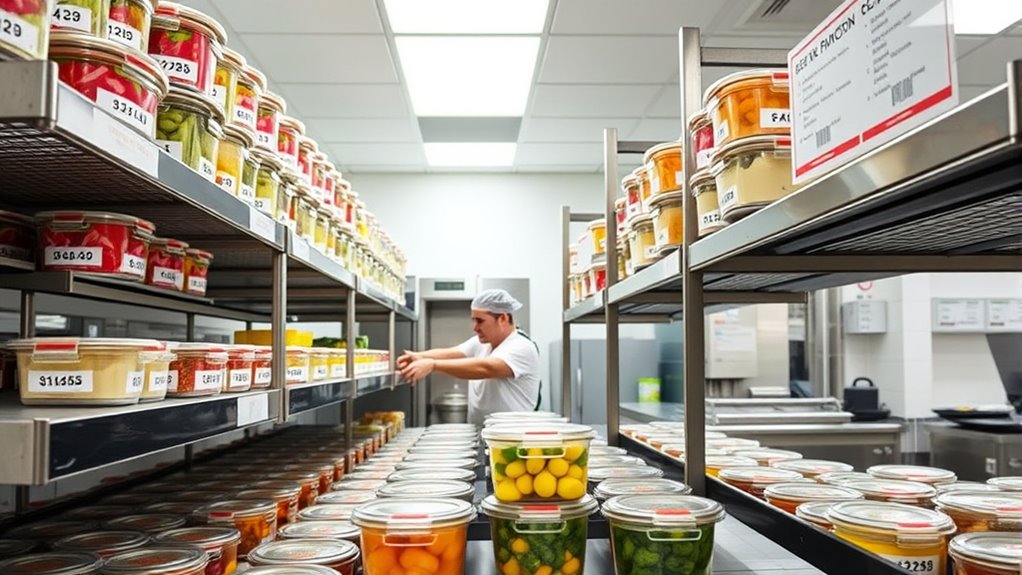
To prevent spoilage, you need a clear food rotation system like FIFO. Make sure every item is labeled properly and used in the order it arrives. Regular inventory checks help you catch potential issues before they become problems. Incorporating proper organization techniques can further enhance your ability to maintain an effective system.
Label Every Item Clearly
Label every item clearly to guarantee you can easily identify its contents and date of purchase. Proper food labeling is essential for effective code interpretation and preventing spoilage. Use clear, legible labels with consistent formats, including the purchase or expiration date. This helps you quickly assess which items need to be used first and reduces confusion. When labeling, avoid vague descriptions; specify exactly what the item is and when it was bought. Stick to a system that everyone understands, making it easier to manage inventory and follow food rotation protocols. Accurate labeling minimizes the risk of using expired food and ensures compliance with safety standards. Remember, clear food labeling is the foundation of an organized and safe storage system, preventing spoilage and waste. Additionally, implementing a family photoshoot fails system can help identify items that are no longer suitable for consumption and prevent unintentional spoilage.
Use First-In, First-Out
Have you ever opened a container only to find spoiled food because it wasn’t used in time? That’s a common issue when you don’t follow a first-in, first-out (FIFO) system. Implementing a clear food rotation system helps guarantee you use items before they expire, maintaining ideal food freshness. Always check expiration dates and place newer stock behind older items so that the oldest products get used first. This practice is similar to how consistent use of eye patches can improve skin hydration and reduce puffiness, as the benefits are maximized with proper application timing. This simple food safety practice prevents spoilage and reduces waste. Consistently applying FIFO keeps your inventory organized and minimizes the risk of serving or consuming outdated food. Remember, a well-maintained rotation system not only safeguards your customers’ health but also keeps your operation compliant with safety standards. Stick to FIFO, and spoiled food won’t catch you off guard.
Regular Inventory Checks
Regular inventory checks are essential to maintaining an effective food rotation system. By regularly inspecting your stock, you ensure inventory freshness and prevent spoilage. These checks help you identify expired or near-expiry items, allowing you to remove them promptly. Consistent monitoring supports proper stock rotation, ensuring older products are used first (FIFO). This process reduces waste and minimizes the risk of serving spoiled food. When you perform these checks, you can also verify that storage conditions are ideal, further preserving food quality. Incorporate a routine schedule for inventory inspections—daily or weekly—to stay on top of stock levels and freshness. Recognizing angel number patterns can also serve as a spiritual reminder to maintain vigilance and stay aligned with your health and safety goals. Staying proactive with inventory checks keeps your food safe, fresh, and compliant with safety standards.
Regularly Inspect and Record Food Conditions and Dates

You need to follow a routine inspection schedule to catch spoiled food early. Make sure to accurately record each item’s condition and expiration dates to keep track of freshness. Timely date tracking helps you prevent using expired products and reduces waste. Incorporating proper storage techniques ensures your food remains fresh longer and minimizes spoilage risks.
Routine Inspection Schedule
How often should food conditions be verified to ensure safety? Regular inspections are essential for maintaining food safety and proper storage techniques. You should review your inventory at least once daily, focusing on perishables and items nearing expiration. Establish a routine schedule, such as inspections every morning and evening, to catch spoiled or compromised food early. During inspections, check for signs of spoilage, leaks, or damage. Record the condition and dates of each item to track freshness and identify trends. Consistent inspections help prevent foodborne illnesses and guarantee compliance with safety standards. Additionally, utilizing proper ventilation considerations can help maintain optimal storage conditions and reduce spoilage risks. By staying diligent and adhering to a strict schedule, you minimize risks and keep your storage environment safe for everyone.
Accurate Condition Documentation
Keeping detailed records of food conditions and expiration dates guarantees that your inventory stays safe and organized. Regular inspections help you identify spoilage indicators like changes in texture, color, or smell. Accurate condition documentation involves checking food labeling carefully, noting the date when items are received or opened, and recording any signs of deterioration. Consistently recording these details ensures you’re aware of which items are approaching their shelf life or showing early spoilage signs. Using professional equipment for inspections can improve the accuracy of your assessments. This proactive approach minimizes waste and prevents serving unsafe food. By maintaining precise records, you create a clear history of food conditions, making it easier to spot trends and enforce compliance. Proper documentation is the backbone of effective food safety management, helping you stay ahead of spoiled food issues.
Timely Date Tracking
Regularly inspecting and recording food conditions and dates is essential for maintaining a safe inventory. Effective expiration tracking helps you identify spoiled items before they become a health hazard. Consistent date management ensures you know exactly when food was received, opened, or prepared. By checking your inventory frequently, you can catch expired products early and prevent contamination. Use clear labels and keep records updated to avoid confusion. Implement a routine schedule for inspections—daily or weekly—so you never miss critical expiration dates. This proactive approach minimizes waste, improves safety, and keeps your operation compliant with health standards. Staying on top of date management and expiration tracking means you’ll always know which items are safe to use and which need to be discarded, safeguarding both your team and your customers.
Know How to Properly Handle and Dispose of Spoiled Items

When you discover spoiled food, it’s essential to handle it properly to prevent health hazards and contamination. First, wear gloves and use designated tools to avoid cross-contamination. Place the spoiled items in a sealed, leak-proof bag to contain odors and prevent spills. Dispose of spoiled food promptly in an outdoor trash bin, away from other supplies. Always clean and sanitize surfaces and tools afterward to maintain food safety standards. Use the following table as a quick reference:
| Step | Action |
|---|---|
| Identify spoiled food | Check for unusual odor, texture, or appearance |
| Seal and contain | Use leak-proof bags to prevent leaks |
| Dispose properly | Take to outdoor trash immediately |
| Sanitize surfaces | Clean with food-safe disinfectant |
Proper handling minimizes risks and keeps your environment safe.
Train Staff on Recognizing and Responding to Food Spoilage Signs

To guarantee food safety, it’s essential that staff can accurately recognize the signs of spoilage. Proper staff training ensures everyone knows what to look for, such as changes in color, texture, or odor. You should teach your team to inspect products regularly and identify common spoilage indicators like mold, sliminess, or sour smells. Responding quickly is critical; once spoilage is detected, staff must follow procedures for proper disposal and documentation. Clear training also helps prevent contamination and reduces food waste. Incorporate visual aids and hands-on practice to reinforce learning. Educated staff not only protect customers but also uphold your establishment’s safety standards. Ongoing training keeps everyone sharp and prepared to handle spoilage signs effectively, maintaining high food safety standards at all times.
Keep Up-To-Date With Local and Federal Food Safety Regulations
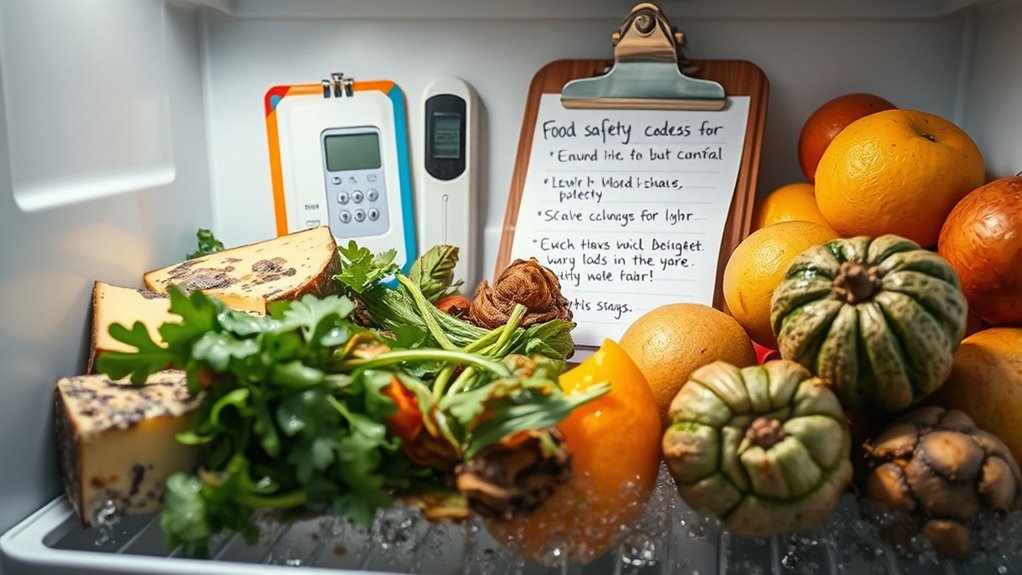
Staying compliant with evolving food safety regulations is essential to maintaining a safe and reputable operation. Regulations frequently change, so it’s crucial to stay informed about local and federal guidelines. Ignoring updates can lead to violations, fines, or food recalls. Many food safety myths circulate, so rely on official sources rather than outdated advice. Regularly review updates from agencies like the FDA or USDA to ensure your policies align with current standards. This proactive approach helps with spoilage prevention by ensuring proper storage, handling, and documentation practices. Staying current also demonstrates your commitment to food safety, building customer trust. Make it a habit to check for regulation updates and participate in training sessions to keep your team informed and compliant at all times.
Maintain Accurate Documentation for Compliance and Audits
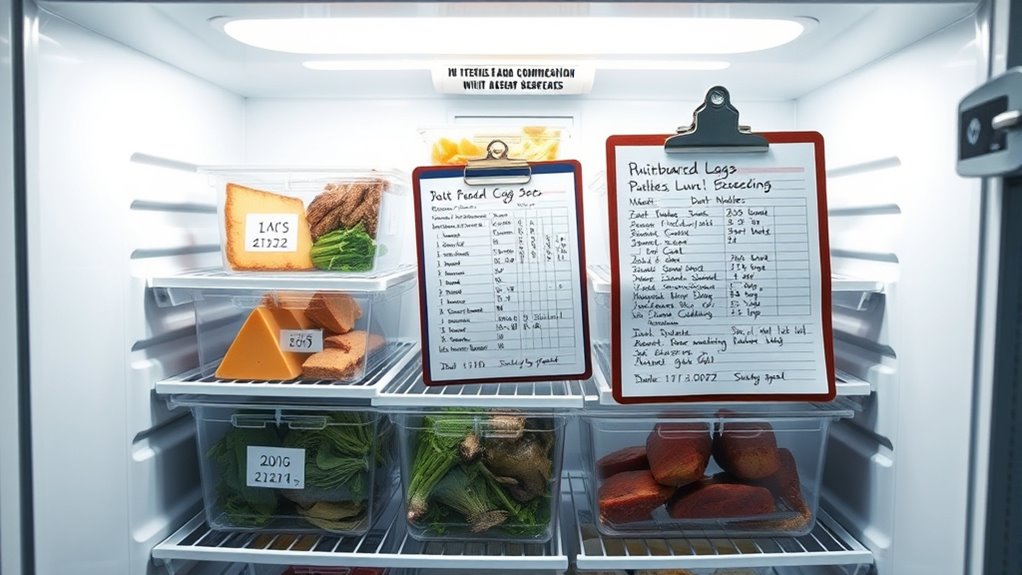
You need to keep detailed records of spoiled food codes to stay compliant and pass audits. Use best practices for record keeping, like clear logs and consistent updates, to guarantee accuracy. Incorporate digital tools and schedule regular audits to identify issues early and maintain proper documentation.
Record Keeping Best Practices
Maintaining accurate documentation is essential for ensuring compliance and passing audits when dealing with spoiled food codes. Proper record keeping supports food safety training and streamlines inventory management, reducing errors and contamination risks. To stay compliant, keep detailed logs of spoilage incidents, including dates, reasons, and corrective actions. Consistently update these records to reflect current status. Use clear labeling and organized filing systems to locate information quickly. Regularly review your documentation practices to identify gaps and improve accuracy. Remember, thorough records not only demonstrate compliance but also help prevent future spoilage issues. Good record keeping builds accountability and ensures your team follows safety protocols diligently.
- Document spoilage incidents immediately
- Use consistent labeling standards
- Keep digital backups of critical data
- Train staff on proper record procedures
- Regularly audit your documentation system
Digital Documentation Tools
Digital documentation tools have become essential for accurately tracking spoiled food incidents and ensuring compliance. They streamline record-keeping by securely capturing data with digital signatures, confirming authenticity and accountability. Using cloud storage allows you to access records anytime, anywhere, facilitating real-time updates and easy sharing with auditors. These tools reduce errors associated with manual logs and guarantee your documentation remains organized and tamper-proof. Automated timestamps and secure access controls further enhance your ability to maintain transparent, reliable records. By leveraging digital signatures and cloud storage, you simplify compliance processes, reduce risks of discrepancies, and demonstrate adherence to food safety regulations effortlessly. Implementing these tools keeps your documentation accurate, accessible, and audit-ready at all times.
Regular Audit Procedures
Regular audit procedures are essential for guaranteeing that your food safety documentation remains accurate and compliant with regulations. Consistently reviewing records helps identify gaps in your inspection procedures and confirms proper handling of spoiled food codes. When conducting audits, focus on verifying that logs are complete, timestamps are correct, and corrective actions are documented. This maintains transparency and supports compliance during inspections. To streamline the process, consider these key steps:
- Cross-check documentation against actual inventory
- Verify expiration dates and spoilage logs
- Ensure proper training records are up-to-date
- Review previous inspection reports for recurring issues
- Confirm corrective actions were implemented correctly
Establish a Protocol for Handling Food Code Discrepancies

When you identify a discrepancy in a food code, it’s essential to have a clear and consistent protocol in place. This guarantees food safety isn’t compromised and spoilage prevention measures are maintained. First, immediately document the discrepancy with detailed notes and photos. Next, isolate the affected products to prevent cross-contamination. Communicate the issue to your team and follow established procedures for corrective action. Assign responsibilities to check inventory, verify code accuracy, and determine if products are still safe for use. Keep records of all steps taken and decisions made. Regularly review and update your protocol to adapt to new challenges. Having a solid process helps you respond swiftly, maintain compliance, and uphold food safety standards, reducing spoilage risks effectively.
Frequently Asked Questions
How Do I Interpret Ambiguous or Unclear Food Date Labels?
When interpreting ambiguous or unclear food date labels, focus on spoilage indicators like bad smell, sliminess, or discoloration instead of just the date. Trust your senses and assess the food’s appearance and texture. Remember, date label interpretations can vary, but spoilage signs are more reliable indicators of safety. If in doubt, it’s safer to discard it rather than risk foodborne illness. Always stay cautious with uncertain food.
What Are Common Signs of Hidden or Subtle Spoilage?
You can spot hidden or subtle spoilage by paying attention to visual cues like mold, discoloration, or slimy textures. Microbial growth often appears as fuzzy patches or unusual spots on food surfaces. Even if food smells normal, these visual signs suggest it’s unsafe. Always inspect carefully, especially with leftovers or packaged items, and trust your senses—if something looks off, it’s better to discard it to avoid foodborne illness.
How Often Should Staff Be Retrained on Food Code Compliance?
You should schedule staff refresher trainings on food code compliance at least every six months. Even if your team seems confident, regular food safety audits reveal gaps, and ongoing education keeps everyone sharp. Don’t wait for problems to arise—by staying proactive, you guarantee compliance and reduce risks. Frequent updates also reinforce best practices, making food safety second nature for your staff and protecting your customers and reputation.
What Are the Consequences of Non-Compliance With Food Codes?
If you don’t comply with food codes, you risk failing food safety audits, which can lead to serious legal penalties. Non-compliance might result in fines, shutdowns, or even lawsuits if customers get sick. You could also damage your reputation and lose customer trust. Staying on top of food safety standards helps you avoid these consequences, ensuring your business remains compliant and safe for everyone.
How Can Technology Improve Food Safety Tracking and Documentation?
Think of technology as your vigilant guardian. By using digital recordkeeping, you can keep track of food safety data effortlessly, like a well-organized diary. Real-time monitoring acts as your watchful eye, alerting you instantly to temperature changes or spoilage risks. This way, you stay ahead of issues, ensure compliance, and protect your customers. Embracing these tools transforms a chaotic process into a streamlined, foolproof system.
Conclusion
By mastering these 10 rules, you’ll become the ultimate guardian of food safety, preventing spoilage from spiraling into a disaster. Remember, neglecting proper codes and compliance isn’t just a minor slip—it’s like opening the floodgates to chaos in your kitchen. Stay vigilant, stay informed, and treat food safety like your most precious treasure. Because in this game, a single mistake can turn your reputation into a sinking ship—don’t let that happen.
